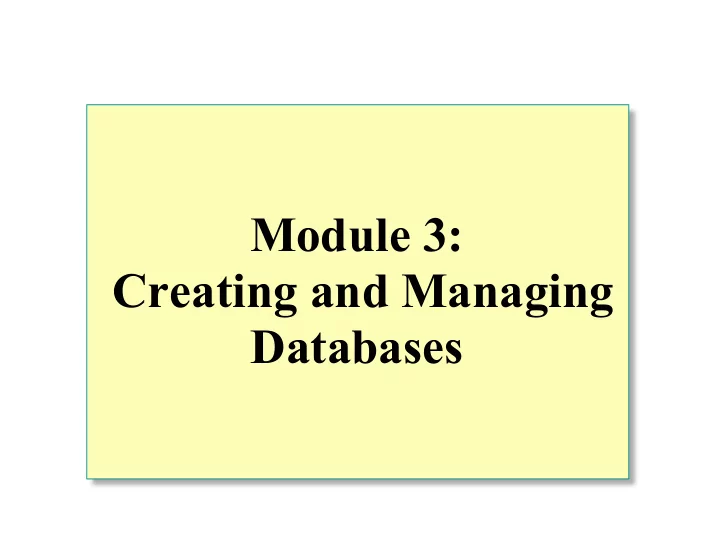

Module 3: Creating and Managing Databases
Overview Creating Databases Creating Filegroups Managing Databases Introduction to Data Structures
Creating Databases Defining Databases How the Transaction Log Works Setting Database Options Retrieving Database Information
Defining Databases Creating a Database Defines: The name of the database The size of the database The files where the database will reside CREATE DATABASE Sample ON PRIMARY ( NAME=SampleData, FILENAME='c:\Program Files\..\..\Data\Sample.mdf', SIZE=10MB, MAXSIZE=15MB, FILEGROWTH=20%) LOG ON ( NAME=SampleLog, FILENAME= 'c:\Program Files\..\..\Data\Sample.ldf', SIZE=3MB, MAXSIZE=5MB, FILEGROWTH=1MB) COLLATE SQL_Latin1_General_Cp1_CI_AS
How the Transaction Log Works Data modification is 1 1 Modification is recorded sent by application 3 3 in transaction log on disk Buffer Cache Disk Disk Data pages are located in, 2 2 or read into, buffer cache and modified Checkpoint writes 4 4 committed transactions to database
Retrieving Database Information Determine Database Properties by Using the DATABASEPROPERTYEX Function Use System Stored Procedures to Display Information About Databases and Database Parameters sp_helpdb sp_helpdb database_name sp_spaceused [ objname ]
Creating Filegroups Northwind Database sys... sys... ... ... sys... sys... Orders Orders OrdHistYear2 OrdHistYear2 sysusers sysusers Customers Customers OrdHistYear1 OrdHistYear1 sysobjects sysobjects Products Products E:\ C:\ D:\ OrdHist1.ndf Northwind.Idf Northwind.mdf OrdHist2.ndf ndf is data file; Default Filegroup OrderHistoryGroup ldf is log file
Managing Databases Managing Data and Log File Growth Monitoring and Expanding a Transaction Log Shrinking a Database or File Dropping a Database
Managing Data and Log File Growth Using Automatic File Growth Expanding Database Files Adding Secondary Database Files ALTER DATABASE Sample MODIFY FILE ( NAME = 'SampleLog', SIZE = 15MB) GO ALTER DATABASE Sample ADD FILE (NAME = SampleData2, FILENAME='c:\Program Files\..\..\ Data\Sample2.ndf', SIZE=15MB, MAXSIZE=20MB) GO
Monitoring and Expanding a Transaction Log Monitoring the Log Monitoring Situations That Produce Extensive Log Activity Mass loading of data into indexed table Large transactions Performing logged text or image operations Expanding the Log When Necessary
Shrinking a Database or File Shrinking an Entire Database DBCC SHRINKDATABASE (Sample, 25) Shrinking a Data File in the Database DBCC SHRINKFILE (Sample_Data, 10) Shrinking a Database Automatically Set autoshrink database option to true
Dropping a Database Methods of Dropping a Database SQL Server Enterprise Manager DROP DATABASE statement DROP DATABASE Northwind, pubs Restrictions on Dropping a Database While it is being restored When a user is connected to it When publishing as part of replication If it is a system database
Introduction to Data Structures How Data Is Stored Types of Pages and Extents Pages That Manage File Space Pages That Track Tables and Indexes
How Data Is Stored Database Database Data (file) Log (file) .mdf or .ndf .Idf Tables, Extent Indexes (8 contiguous 8-KB pages) Data Page (8 KB) Max row size = 8060 bytes
Types of Pages and Extents Types of Pages Pages that track space allocation Pages that contain user and index data Types of Extents Mixed Uniform Free Extent Extents Space
Pages That Manage File Space Page number 0 1 1 2 3 4 5 6 7 0 2 3 File Header PFS: Page Free Space = info about the PFS free space on the page GAM GAM: Global Allocation Map = SGAM information about allocated extents SGAM: Secondary GAM = information about allocated mixed extents
Pages That Track Tables and Indexes Mixed Extents Uniform Extents IAM Data Page Pages 3-8 Data IAM = info about extents used by table/index
Review Creating Databases Creating Filegroups Managing Databases Introduction to Data Structures
Recommend
More recommend